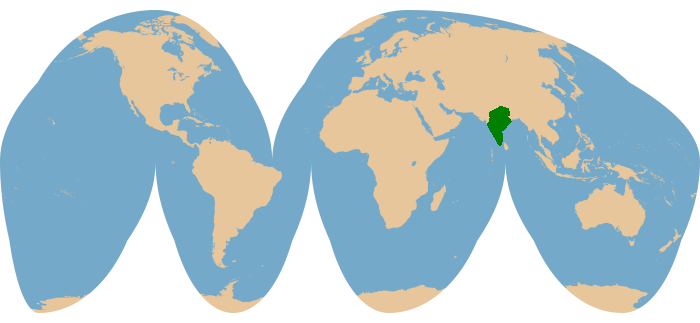Kingdom: |
Animalia Chordata Mammalia Artiodactyla Ruminantia Tragulidae Moschiola |
Common name:
Scientific name:
Other names: |
Indian chevrotain
Moschiola indica
Indian spotted chevrotain, Pisura, Khedbi, Ramgai, Musemriga |
Physical Characteristics
- Head and body length:
48-60 cm
- Shoulder height: 25-33 cm
- Tail length: 3-6 cm
- Adult weight: 3 kg, although weights of up to 5.45 kg have been reported.
- Shoulder height: 25-33 cm
The largest member of the genus Moschiola. The Indian chevrotain has short front limbs, relatively long hind limbs, and an arched back. The general coloration is a dull brown with pale underparts. Four or five loose rows of white spots mark the flanks, and three broken bands of white cross the rump. The individual pattern of spots (which occasionally merge together to form short longitudinal stripes) is unique, and has been use to recognize animals in remote camera images. The underside of the throat has two pairs of lateral stripes, connected by a continuous white stripe which extends from the chin to the pale belly. The top of the head, including the forehead and a wedge between the eyes, is dark brown. Males develop prominent tusk-like upper canines.
- Similar species
- The Indian chevrotain is readily distinguished from the congeneric white-spotted chevrotain (Moschiola meminna) and yellow-striped chevrotain (Moschiola kathygre), both native to Sri Lanka, by distribution. The Indian chevrotain is also larger than the other two species.
- The water chevrotain (Hyemoschus aquaticus) is superficially similar, with a stripe-and-spot pattern on a reddish-brown coat; the water chevrotain is larger and easily distinguished by its African distribution.
Reproduction and Development
- Gestation period:
154 days.
- Litter size: One, occasionally twins.
- Sexual maturity: Females at 5-5.5 months.
- Litter size: One, occasionally twins.
Indian chevrotains breed throughout the year, although birth rates are higher from September to February, the period following the monsoon season. Copulation takes place with the female lying down, and it has been reported that a female will breed only once per estrous cycle. Neonates weigh an average of 470 g at birth. Like other chevrotains, females will return to estrus within 4-6 hours of giving birth.
Ecology and Behavior
- Family group:
Generally solitary, sometimes seen in pairs.
- Diet: Fallen fruits, also potentially leaves, buds, and shoots.
- Main Predators: Tiger, leopard, and smaller cats, dhole, martens, eagles, owls, pythons, crocodiles.
- Diet: Fallen fruits, also potentially leaves, buds, and shoots.
Habitat and Distribution

Conservation Status
- IUCN Red List: Least Concern (2015).
- CITES Listing: Not listed (2019).
- Threats: Hunting, potentially habitat destruction or conversion.
- CITES Listing: Not listed (2019).
The global population of the Indian chevrotain has not been assessed. It is widespread, but is one of the most frequently-hunted species within its range, and sustained hunting (through net drives, snares, pit traps, and dogs) is thought to be responsible for localized reductions in numbers.
